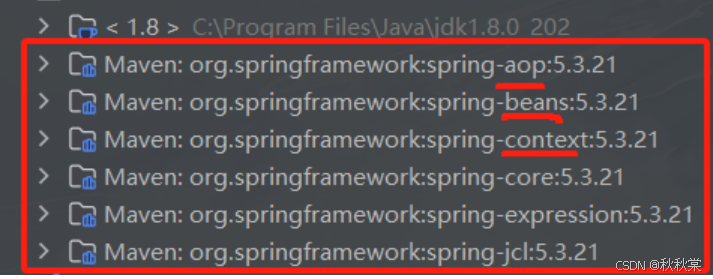Spring核心机制:深入理解控制反转(IoC)
Spring核心机制:深入理解控制反转(IoC)
IoC的本质:控制权反转
在传统开发中,创建对象的责任由开发者承担。但在Spring框架中,这一责任被转移给了IoC容器。这种控制权转移就是"反转"的核心含义:
具体来说:
- 传统方式:开发者通过
new关键字直接创建对象 - Spring方式:IoC容器负责创建对象,开发者只需从容器中获取
传统对象创建方式
实体类定义
// src/main/java/com/test/entity/Student.java
package com.test.entity;public class Student {private Integer id;private String name;private Integer age;// 省略Getter/Setter/toString
}
手动创建对象
// src/main/java/com/Test.java
package com;import com.test.entity.Student;public class Test {public static void main(String[] args) {// 开发者手动创建对象Student student = new Student();student.setId(1);student.setName("张三");student.setAge(18);System.out.println(student);}
}
Spring IoC创建对象
1. 添加依赖(pom.xml)
<dependencies><dependency><groupId>org.springframework</groupId><artifactId>spring-context</artifactId><version>5.3.21</version></dependency>
</dependencies>

确保正确引入依赖
2. 配置文件(spring.xml)
<!-- src/main/resources/spring.xml -->
<?xml version="1.0" encoding="UTF-8"?>
<beans xmlns="http://www.springframework.org/schema/beans"xmlns:xsi="http://www.w3.org/2001/XMLSchema-instance"xsi:schemaLocation="http://www.springframework.org/schema/beans http://www.springframework.org/schema/beans/spring-beans.xsd"><!-- 配置Student对象 --><bean id="student" class="com.test.entity.Student"><property name="id" value="1"/><property name="name" value="张三"/><property name="age" value="22"/></bean>
</beans>
3. 从IoC容器获取对象
// src/main/java/com/Test.java
package com;import com.test.entity.Student;
import org.springframework.context.ApplicationContext;
import org.springframework.context.support.ClassPathXmlApplicationContext;public class Test {public static void main(String[] args) {// 加载Spring配置ApplicationContext ioc = new ClassPathXmlApplicationContext("spring.xml");// 从容器获取对象Student student = (Student) ioc.getBean("student");System.out.println(student);}
}
IoC底层原理:反射机制
Spring IoC容器通过反射技术动态创建对象:
public static void createObjectByReflection() {try {// 1. 加载类信息Class<?> clazz = Class.forName("com.test.entity.Student");// 2. 获取构造器Constructor<?> constructor = clazz.getConstructor();// 3. 创建对象实例Object instance = constructor.newInstance();// 4. 设置属性值(简化示例)Method setId = clazz.getMethod("setId", Integer.class);setId.invoke(instance, 1);System.out.println(instance);} catch (Exception e) {e.printStackTrace();}
}
为什么默认使用无参构造器?
当IoC容器需要创建多种类型的对象时:
- 无法提前知道类的具体结构
- 无参构造器是Java类的默认构造器
- 无需指定参数,创建过程统一且简单
高级IoC特性
多种获取Bean的方式
1. 通过ID获取
Student student = (Student) ioc.getBean("student");
2. 通过类型获取
Student student = ioc.getBean(Student.class);
注意:当容器中存在多个同类型Bean时,通过类型获取会抛出
NoUniqueBeanDefinitionException
有参构造器创建对象
实体类配置构造器
public class Student {public Student(Integer id, String name, Integer age) {// 构造逻辑}// 必须显式声明无参构造器public Student() {}
}
XML配置
<bean id="student3" class="com.test.entity.Student"><constructor-arg name="id" value="3"/><constructor-arg name="name" value="王五"/><constructor-arg name="age" value="18"/>
</bean>
对象级联赋值
关联实体类
// Class.java
public class Class {private Integer id;private String name;// getters/setters
}// Student.java
public class Student {private Class clazz; // 关联属性// 其他属性及方法
}
XML级联配置
<bean id="javaClass" class="com.test.entity.Class"><property name="id" value="101"/><property name="name" value="Java高级班"/>
</bean><bean id="student" class="com.test.entity.Student"><property name="id" value="1"/><property name="clazz" ref="javaClass"/> <!-- 关联引用 -->
</bean>
IoC容器的核心优势
| 特性 | 传统方式 | Spring IoC |
|---|---|---|
| 对象创建 | 开发者控制 | 容器控制 |
| 耦合度 | 高耦合 | 低耦合 |
| 可维护性 | 修改困难 | 配置修改即可 |
| 对象管理 | 分散管理 | 集中管理 |
| 测试难度 | 需要真实对象 | 轻松模拟依赖 |
总结
- 控制反转(IoC) 本质是对象创建权的转移
- Spring通过反射机制实现对象的动态创建
- XML配置是定义Bean的经典方式
- IoC容器支持多种对象获取方式和复杂对象关系管理
- 级联赋值简化了对象间的依赖管理
“不要调用我们,我们会调用你” - IoC的核心理念,将程序控制权交给框架
掌握IoC机制是深入理解Spring框架的基础,它通过解耦组件依赖关系,大幅提高了代码的灵活性和可维护性。
